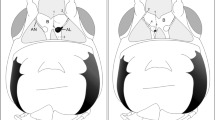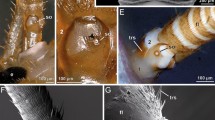Summary
Short peg receptors located at the distal tip of the aphid labium have the structure of mechanoreceptors. Each peg is innervated by a single sensory nerve which is anchored eccentrically to a basal cuticular tube and terminates in electron-dense material in the base of the peg. The arrangement and eccentric insertion of the eight pegs in the labial wall on one side of the stylet groove, with the eccentric insertions of their innervating neurones, provide a mirror image of the receptors on the opposite side. On the basis of a comparison of the structure of these receptors with that of tactile receptors for which electrophysiological data on sensitivity are available, it is possible to predict that the receptors detect both surface contact (pressure) and surface profile; and that the bilateral symmetry in the receptor arrangement facilitates the detection of vein contours which are preferred settling sites on the leaf. The structure of the dendritic terminal and its insertion is that of a well reinforced cytoskeleton designed to transmit tension to the cell membrane, in agreement with the concept that transduction is a membrane related phenomenon. The distal microtubules, fifty per-cent of which originate as well as terminate in the “tubular body”, are packed in electron-dense material which binds to the cell membrane. The membrane in turn is attached to cuticular components of the receptor. Abrupt changes in dimension of the dendritic outer segment may be designed to modulate the conduction of a membrane potential. On the other hand, lack of continuity in the microtubules makes these organelles poor candidates for the transduction of excitation from a distal site of stimulation to a proximal region.
Similar content being viewed by others
References
Adams, J.B., Fyfe, F.W.: Stereoscan views of some aphid mouthparts. Canad. J. Zool. 48, 1033–1034 (1970)
Atema, J.: Microtubule theory of sensory transduction. J. theor. Biol. 38, 181–190 (1973)
Brown, K.T., Watanabe, K., Marakami, M.: The early and late receptor potentials of monkey cones and rods. Cold Spr. Harb. Symp. quant. Biol. 30, 457–482 (1965)
Camhi, J.M.: Locust wind receptors. I Transducer mechanics and sensory response. J. exp. Biol. 50, 335–348 (1969)
Chevalier, R.L.: The fine structure of campaniform sensilla on the halteres of Drosophila melanogaster. J. Morph. 128, 443–464 (1969)
Forbes, A.R.: Mouthparts of sucking insects. “Canada Agriculture”, 3 pp. Spring 1974
Hennig, E.: Zum Probieren oder sogenannten Probesaugen der schwarzen Bohnenlaus (Aphis fabae Scop.). Ent. exp. & appl. 6, 326–336 (1963)
Ibbotson, A., Kennedy, J.S.: Interaction between walking and probing in Aphis fabaeScop. J. exp. Biol. 36, 377–390 (1951)
Kennedy, J.S., Booth, C.O.: Co-ordination of successive activities in an aphid. The effect of flight on the settling responses. J. exp. Biol. 40, 351–369 (1963)
Klingauf, F.: Die Wirkung des Glucosids Phlorizin auf das Wirtswahlverhalten von Rhopalosiphum insertum (Walk.) und Aphis pomi DeGeer (Homoptera: Aphididae). Z. ang. Ent. 68, 41–55 (1971)
Lettvin, J.Y., Platt, J.R., Wald, G., Brown, K.T.: General Discussion: Early receptor potential. Cold Spr. Harb. Symp. quant. Biol. 30, 501–504 (1965)
Loewenstein, W.R.: Facets of a transducer process. Cold Spr. Harb. Symp. quant. Biol. 30, 29–43 (1965)
Loewenstein, W.R., Rathkamp, R.: The sites for mechano-electric conversion in a Pacinian corpuscle. J. gen. Physiol. 41, 1245–1265 (1958)
Lowenstein, O., Osborne, M.P., Wersäll, J.: Structure and innervation of the sensory epithelia of the labyrinth in the Thornback ray (Raja clavata). Proc. roy. Soc. B 160, 1–12 (1964)
Marek, J.: Über das Einstichund Saugverhalten der Zwiebellaus, Myzus ascalonicusDoncaster. Z. Pflanzenkrankh. 68, 155–165 (1961)
McIver, S.B.: Structure of cuticular mechanoreceptors of arthropods. Ann. Rev. Entomol. 20, 381–397 (1975)
Mellon, Def., Kaars, C.: Role of regional cellular geometry in conduction of excitation along a sensory neuron. J. Neurophysiol. 27, 1228–1238 (1974)
Moran, D.T., Chapman, K.M., Ellis, R.A.: The fine structure of cockroach campaniform sensilla. J. Cell Biol. 48, 155–173 (1971)
Moran, D.T., Varela, F.G.: Microtubules and sensory transduction. Proc. nat. Acad. Sci. (Wash.) 68, 757–760 (1971)
Morita, H.: Initiation of spike potentials in contact chemosensory hairs of insects. III. D.C. stimulation and generator potentials of labellar chemoreceptor of Calliphora. J. cell comp. Physiol. 54, 189–204 (1959)
Müller, H.J.: Über die Ursachen der unterschiedlichen Resistenz von Vicia faba L. gegenüber der Bohnenblattlaus, Aphis (Doralis) fabae Scop. VIII. Das Verhalten geflügelter Bohnenläuse nach der Landung auf Wirten und Nichtwirten. Ent. exp. & appl. 5, 189–210 (1962)
Penn, R.D., Hagins, W.A.: Signal transmission along retinal rods and the origin of the electroretinographic a-Wave. Nature (Lond.) 223, 201–205 (1969)
Schoonhoven, L.M.: Some aspects of host selection and feeding in phytophagous insects. Insect and mite nutrition, pp. 557—566. Amsterdam: North Holland 1972
Schoonhoven, L.M., Henstra, S.: Morphology of some rostrum receptors in Dysdercus spp. Neth. J. Zool. 22, 343–346 (1972)
Slifer, E.H., Lees, A.D.: The sense organs on the antennal flagellum of aphids (Homoptera), with special reference to the plate organs. Quart. J. micr. Sci. 105, 21–29 (1964)
Smith, D.S.: The fine structure of haltere sensilla in the blowfly Calliphora erythrocephala (Meig.) with scanning electron microscopic observations on the haltere surface. Tissue & Cell. 1, 443–484 (1969)
Spira, M.E., Yarom, Y., Parnas, I.: Modulation of spike frequency by regions of special axonal geometry and by synaptic inputs. J. Neurophysiol. 39, 882–899 (1976)
Spurr, A.R.: A low-viscosity epoxy resin embedding medium for electron microscopy. J. Ultrastruct. Res. 26, 31–43 (1969)
Stearns, M.E., Connolly, J.A., Brown, D.L.: Cytoplasmic microtubule organizing centers isolated from Polytomella agilis. Science 191, 188–191 (1976)
Tateda, H., Morita, H.: Initiation of spike potentials in contact chemosensory hairs of insects. I. The generation site of the recorded spike potentials. J. cell and comp. Physiol. 54, 171–176 (1959)
Thurm, U.: Die Beziehungen zwischen mechanischen Reizgrößen und stationären Erregungszuständen bei Borstenfeldsensillen von Bienen. Z. vergl. Physiol. 46, 351–382 (1963)
Thurm, U.: Mechanoreceptors in the cuticle of the honey bee: Fine structure and stimulus mechanism. Science 145, 1063–1065 (1964)
Thurm, U.: Steps in the transducer process of mechanoreceptors. Symp. Zool. Soc. Lond. 23, 199–216 (1968)
Tucker, J.B., Meats, M.: Microtubules and control of insect egg shape. J. Cell Biol. 71, 207–217 (1976)
Uga, S., Kuwabara, M.: The fine structure of the campaniform sensillum on the haltere of the fleshfly, Boettcherisia peregrina. J. Electronmicrosc. 16, 304–312 (1967)
Wensler, R.J.D.: Mode of host selection by an aphid. Nature (Lond.) 195, 830–831 (1962)
Wensler, R.J.D.: Sensory physiology of host selection in some aphids. Ph.D. Thesis of the University of Cambridge, 74 pp. (1963)
Author information
Authors and Affiliations
Additional information
Supported by operating grants Nos. A 6063 and A 9856 from NRCC
Rights and permissions
About this article
Cite this article
Wensler, R.J. The fine structure of distal receptors on the labium of the aphid, Brevicoryne brassicae L. (Homoptera). Cell Tissue Res. 181, 409–422 (1977). https://doi.org/10.1007/BF00223115
Accepted:
Issue Date:
DOI: https://doi.org/10.1007/BF00223115




